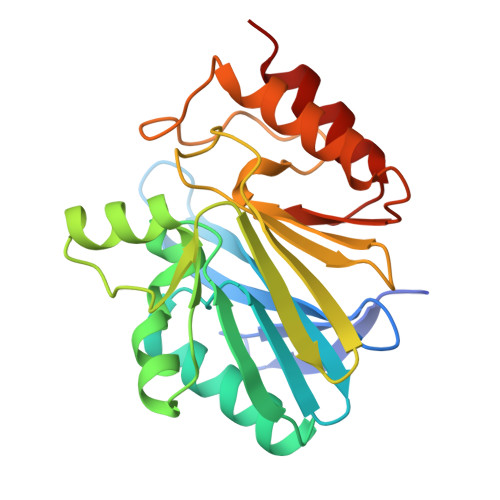Active site loops of membrane-anchored metallo-beta-lactamases from environmental bacteria determine cephalosporinase activity.
Carnevale, M.C., Palacios, A.R., Hinchliffe, P., Delmonti, J., Drusin, S.I., Moreno, D.M., Bonomo, R.A., Spencer, J., Vila, A.J.(2025) Antimicrob Agents Chemother 69: e0191824-e0191824
- PubMed: 40548716
- DOI: https://doi.org/10.1128/aac.01918-24
- Primary Citation of Related Structures:
9GX8, 9GX9 - PubMed Abstract:
Antimicrobial resistance is a significant global public health threat that limits treatment options for bacterial infections. This situation is aggravated by the environmental spread of β-lactamase genes. In particular, metallo-β-lactamases (MBLs) hydrolyze almost all available β-lactam antibiotics, including late-generation cephalosporins and carbapenems. Among MBLs, the New Delhi metallo-β-lactamase (NDM-1) of subclass B1 has shown the most ominous dissemination. NDM variants are the only MBLs of clinical importance that are membrane-anchored, a sub-cellular localization that endows them with high stability under conditions of metal limitation. However, antibiotic resistance predates modern antibiotic usage, and environmental bacteria serve as reservoirs for resistance genes. Here, we report the biochemical and structural characterization of two membrane-bound MBLs: CJO-1 and CIM-2, from Chryseobacterium joostei and Chryseobacterium indologenes , respectively. Both MBLs confer β-lactam resistance on producer bacterial strains and hydrolyze several antibiotics, although with impaired efficiency compared to NDM-1. Crystal structures reveal differences, compared to previously studied B1 MBLs, in the active site loops and their dynamic properties that impact activity. Specifically, a hindered access to the active site with the contribution of a Tyr residue in loop L10 and the presence of a positively charged Lys residue in loop L3 limit hydrolysis of cephalosporins with charged C3 substituents. Some of these novel features are preserved in other MBLs from Chryseobacterium spp. These findings suggest that Chryseobacterium spp. could act as reservoirs of MBL genes, while informing on the diversity of structure-function relationships and dynamic behaviors within the B1 subclass of these enzymes.
- Laboratorio de Metaloproteínas, Instituto de Biologia Molecular y Celular de Rosario (IBR, CONICET-UNR), Rosario, Argentina.
Organizational Affiliation:





















